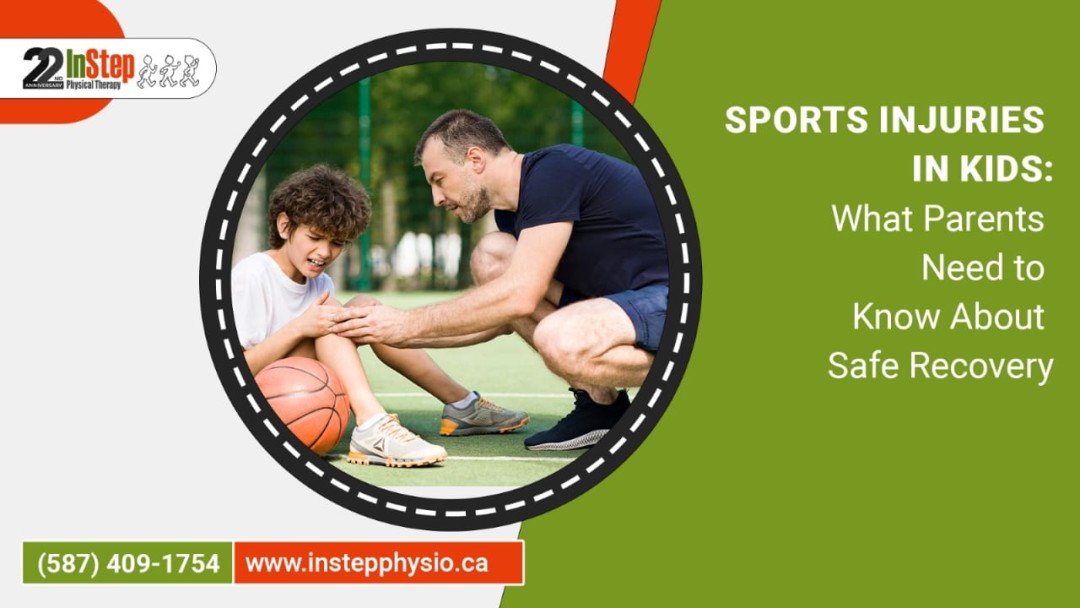
Getting kids involved in sports is a fun and effective way to keep them active, confident, and socially engaged. But alongside all the benefits comes one unavoidable risk: sports injuries in kids. From twisted ankles on the soccer field to shoulder strains in baseball or sprains during gymnastics, injuries can pop up in any sport, any season.
The tricky part? Knowing how to help your child heal without pushing too hard or too little. Achieving a safe recovery is key to avoiding setbacks, and that’s where sports physiotherapy in Edmonton becomes an essential part of the journey. This guide walks parents through the steps to handle injuries smartly and support their child’s full return to activity.
Why Sports Injuries in Kids Are Different
Children and teens aren’t just mini-adults. Their bones are still growing, their muscles are developing, and their coordination is a work in progress. That makes them more vulnerable to certain types of sports injuries and also more responsive to the right kind of treatment.
Injuries like growth plate fractures, Osgood-Schlatter disease, sprains, and repetitive strain injuries are common. Often caused by overtraining, poor form, or collisions during play, these injuries can affect not just physical health but confidence and mental well-being, too. That’s why understanding how to support safe recovery from the start is so important.
Common Types of Sports Injuries in Kids
- Sprains and strains (ankles, knees, wrists)
- Growth plate injuries (often in the knees or elbows)
- Shin splints and stress fractures
- Sever’s disease (heel pain common in active children)
- Rotator cuff strains (especially in baseball or swimming)
- Knee injuries (like patellar tendinitis or ACL strains)
Each of these conditions requires a tailored approach, and that’s where sports physiotherapists play a crucial role in guiding recovery.
Rest Is Important, But It’s Not the Whole Plan
The age-old advice to “just rest” doesn’t always lead to a full, safe recovery. While rest is important during the initial phase of healing, it’s only the beginning. Extended inactivity can cause muscles to weaken or tighten, which may delay progress or cause new issues once the child returns to sports. A well-structured plan for sports injury physiotherapy helps:
- Reduce pain and inflammation
- Restore movement and flexibility
- Build strength and balance
- Address faulty movement patterns
- Rebuild confidence in returning to play
How Sports Physiotherapy Helps
Once the initial inflammation has settled, sports physiotherapy in Edmonton can take recovery to the next level. A thorough assessment identifies not only the injury itself but also any underlying biomechanical issues or weaknesses. A typical sports physiotherapy treatment plan may include:
Assessment: Measuring the Damage and Tracking Progress
Sports physiotherapists begin with a goniometric range of motion testing to measure joint mobility and flexibility. This helps determine how the injury has affected movement and serves as a baseline for tracking recovery milestones over time.
Manual Therapy: Hands-On Healing Techniques
Manual therapy approaches like soft tissue mobilization and gentle joint mobilization help release tight muscles, reduce inflammation, and improve circulation. These techniques are especially useful for treating muscle strains, ligament sprains, and postural imbalances.
Modalities: Tools That Promote Healing
To manage pain and reduce inflammation, physiotherapists may use modalities like TENS (Transcutaneous Electrical Nerve Stimulation) and ultrasound therapy. These help stimulate healing in soft tissues and keep kids comfortable during recovery.
Targeted Exercise Therapy: Rebuilding Strength and Control
Customized exercise programs, including Thera-Band resistance training and functional bodyweight movements, are used to strengthen the injured area without overstressing it. These exercises help kids regain muscular control and overall joint stability.
Balance & Agility Drills: Training for Real-World Movement
To restore balance, agility, and coordination, therapists use tools like the Star Excursion Balance Test and ladder drills. These exercises challenge the nervous system and re-train proprioception, which is essential for sports that involve quick pivots, turns, or lateral motion.
Taping & Bracing: Added Support During Activity
When needed, kinesiology taping and soft orthotic bracing provide additional joint support during activity. These methods stabilize the injured area while still allowing functional movement, helping kids transition safely back into sports.
Education: Teaching Movement That Protects
Proper body mechanics are taught through the dynamic posture re-education method, which helps kids understand how to move safely during both everyday tasks and athletic activities. This reduces the risk of re-injury and encourages long-term healthy movement patterns.
When to Return to Sports After an Injury
Rushing back too soon can undo weeks of progress. It’s important to wait until:
- Pain is gone
- Swelling has resolved
- Strength and mobility are back to normal
- The child can perform sport-specific movements without hesitation
Supporting Recovery at Home
Parents can play a huge role in recovery by:
- Encouraging regular home exercises provided by the physiotherapist
- Monitoring pain levels and movement patterns
- Reinforcing the importance of rest and proper nutrition
- Providing emotional support during setbacks
Keeping open communication with the physiotherapist ensures that any concerns are addressed promptly.
Healing Today, Playing Tomorrow:
Sports injuries in kids don’t have to derail a season or a passion for the game. The right approach after an injury can set the tone for a full, safe, and confident recovery. Recognizing the signs early, getting a proper evaluation, and beginning sports physiotherapy treatment are key steps every parent can take to prevent their child’s long-term athletic health. Whether it’s a sprain, strain, or more complex issue, sports physiotherapy in Edmonton offers practical solutions for healing and performance.
In Step Physical Therapy in Edmonton provides focused, age-appropriate care that helps young athletes return stronger, smarter, and ready to move. Because, for kids who love their sport, recovery isn’t just about healing; it’s about getting back to what they love.
Media Contact
Company Name: Emerald Hills Physio
Contact Person: Sport Clinic
Email: Send Email
Phone: +15878554831
Country: Canada
Website: https://emeraldhillsphysio.com/
